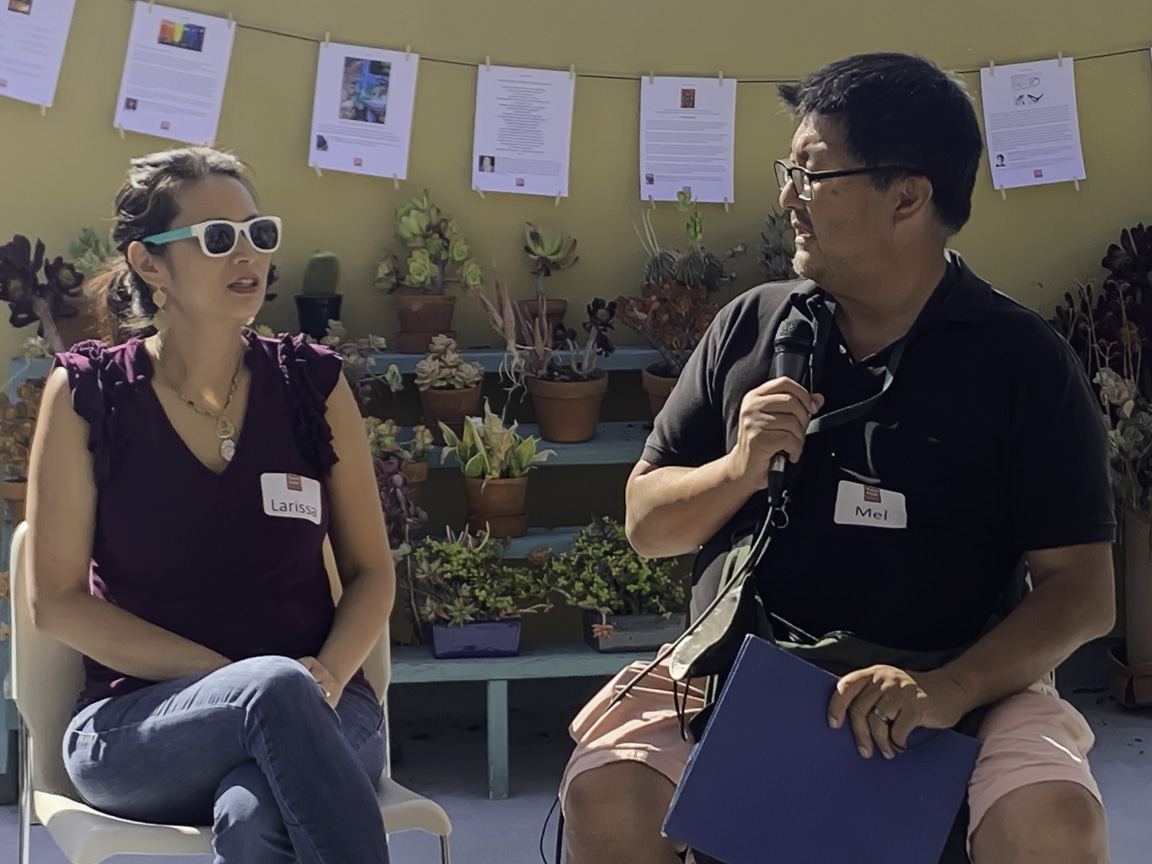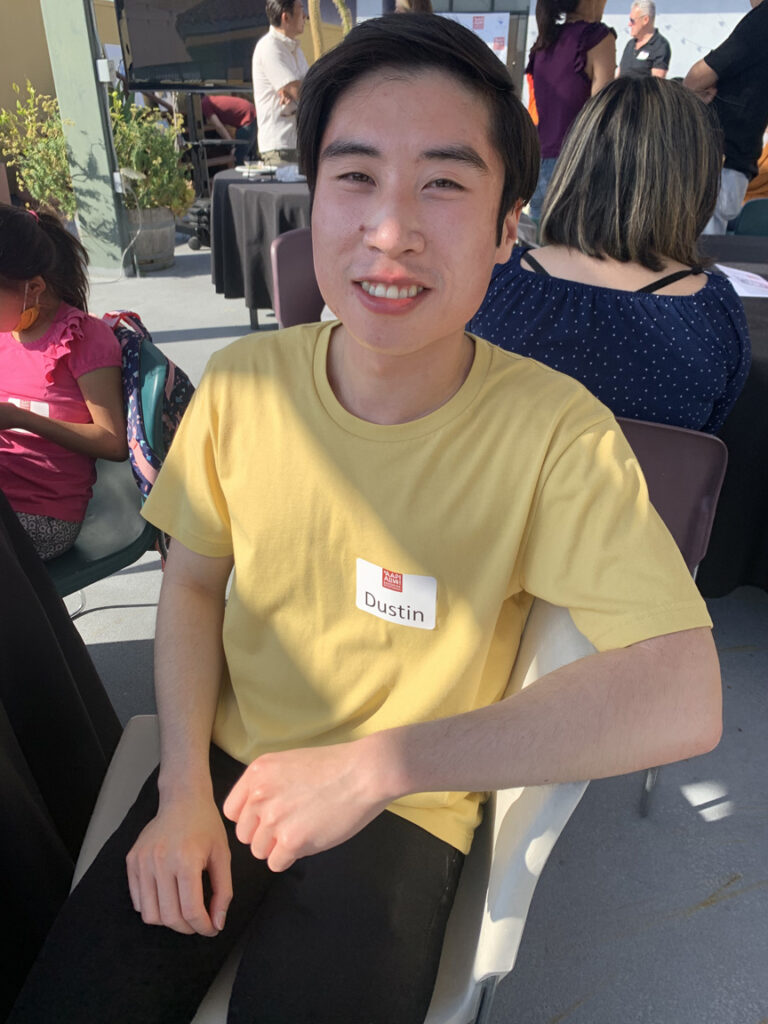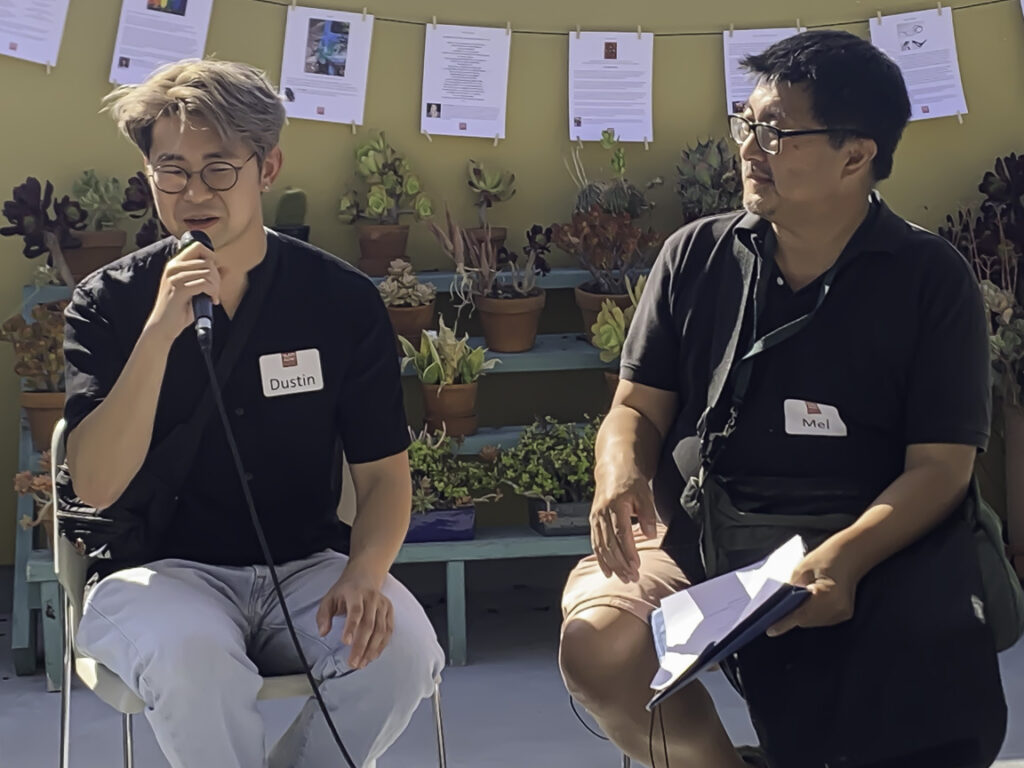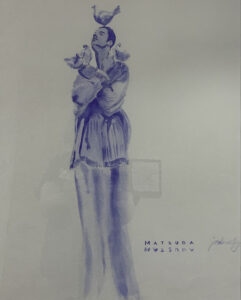
Mel Soriano interviews musician and film director Larissa Lam about her experience discovering Asian American history. Photo: Pat McCaughan
[Diocese of Los Angeles] Since musical artist Larissa Lam directed the award-winning film “Far East Deep South,” about her in-laws’ Mississippi roots, she has “made it my mission to help others discover more Asian American/Pacific Islander history,” she told those attending the May 7 celebration of AAPI Heritage Month on the rooftop of St. Paul’s Commons.
Hosted by The Gathering – A Space for AAPI Spirituality, a ministry of the Diocese of Los Angeles, the May 7 event featured music, art, food, spoken word poetry and prayer. In addition, seminarian Mel Soriano interviewed contributors to The Gathering’s “AAPI Alive!” Eastertide Devotional, which features a new offering every day between Easter Day and Pentecost.
Lam, whose “I Feel Alive” Eastertide Devotional vocal contribution debuted May 8, said she and her husband, Baldwin Chiu, were surprised when tracing his roots “that we ended up, not in China, but in the deep south of Mississippi.
“We uncovered the kind of unknown history that most people don’t realize; that there was a significant population in the deep south, especially the Mississippi Delta, of Chinese over generations. It was an amazing testimony.”
Chiu was attending a screening of the film in Washington, D.C., she said, adding that celebrating AAPI heritage should occur throughout the year, “because AAPI history, just like Black history, is American history.”
Lam and other interviewees also expressed their struggle for recognition, identity, and authenticity within the nation’s ongoing, often mostly Black-white racial conversation. “As somebody that’s American-born who’s Chinese, I never really felt like I fit into any box,” she said.

Dustin Nguyen contributed a trilingual prayer, in English, Spanish and Vietnamese, to the Eastertide Devotional. Photo: Pat McCaughan
“I joke that, when I was growing up, as one of the only Asians in my class in elementary school, I wanted to be blond-haired and blue-eyed, because all the popular kids looked like that. And then I got older and got into music, and all my favorite artists were Black. I was into R&B and jazz. My own style is more akin to that. And then, I’m Asian. So, where do I fit into this? I wasn’t Black. I wasn’t white.”
The Rev. Peter Huang, a leader of The Gathering, echoed Lam’s sentiment, that AAPI history is American history, and as such should be recognized throughout the year. The heritage celebration, however, represented “a wonderful mix of AAPI’s from all walks of life, age, gender, ethnicity, acculturation level, sexuality, gathered together,” he said. “The true diversity of this group, to be able to come together and to celebrate, is quite phenomenal.”
The Eastertide Devotional and the rooftop celebration were both filled with joy, he added — joy “from coming together, and that includes with allies and advocates in our midst, representing a sense of home, as a place where you can tell your story and feel understood and don’t have to footnote and explain everything.”
The celebration also included musical performances by Grupo Arroyo, a ministry of All Saints Church in Pasadena, and spoken-word prayer and poem performances.
Dustin Nguyen offered a trilingual prayer, in English, Spanish and Vietnamese:
“Almighty God who blesses us with the power of art, exalt the voices of artists from historically marginalized communities, cast down the barriers that keep us excluded, multiply the solidarity to our cause, that our stories dignified may transfigure our imaginations and conversations and that we rise together as Beloved Community. Amen.”

Ravi Verma, left, describes to Mel Soriano his contribution to the Eastertide Devotional: a meditation based on the Indian lotus flower. Photo: Pat McCaughan
Ravi Verma, program director for the Stillpoint Center for Christian Spirituality, an institution of the diocese, told the gathering that he explored the paradox of finding beauty in the midst of life’s challenges through the metaphor of an Indian lotus flower. His reflections will be published in an upcoming devotional entry.
Within the context of Eastertide, the events leading up to Jesus’ death were distressing, yet were followed by Easter, new life. Similarly, the lotus exists in muddy waters, he said, yet opens, revealing its beauty, that is always available. “Beauty is not separate from the field. We need to make time to cultivate beauty.”
Despite pain and suffering “there is still a call to recognize the beauty around us, which is what gives us strength,” he said. Looking out at Echo Park Lake, he added: “I see the flowers, I see the ducks and I see the wind in the trees. No matter what I am going through, they are there at the same time.”
Dustin Seo is a cellist with Laós Chamber Music, a Los Angeles-based group of classical musicians supported by the Church of Our Saviour in San Gabriel, and is also associate artistic director of Street Symphony, a group dedicated to building bridges between the music and Skid Row communities.
“I find a lot of my joy and artistic passion in what is perhaps not my heritage,” said Seo, who grew up in South Pasadena and described the cello as a “very white, Western instrument. And yet, I believe that that’s part of the Asian American experience and even more, as an offshoot of that, like my experience as a Christian.

Dustin Seo, cellist, of Laós Chamber Music and Street Symphony, describes how his musical artistry helps him connect to his faith and identity. Photo: Pat McCaughan
“I’ve been really wrestling with my faith and how a big part of my identity as a Christian was a big part of how I assimilated as a child of an immigrant family,” he told the gathering. “I had all those thoughts like, have my relationship with a Christian God and my faith in Christianity actually kept me away from my Asian-ness?”
He added: “I’ve found that it’s OK to say that I like to play the classical cello and that I go to church and worship a Western religion. And it’s okay to say that that is, authentically who I am. I feel like my artistry is my identity and who I am as a person, and that has an intersection with faith and a lot of complicated things.
In “Resurrection,” an April 21 devotional entry, Seo performs a set of gavottes from Johann Sebastian Bach’s D Major Suite for Solo Cello because “it captures the feeling of childish and innocent wonderment,” a sense he feels about the resurrection of Jesus Christ.
“Every year I find myself filled with just, such joy and awe for how amazing our Lord is and the kind of incredible mercy and love that he has for us,” he says in the entry. “It’s really cool we get to celebrate it every single year and honestly every single day. Nothing about it gets old. Every day, I get to wake up as an innocent child and experience love and feel this immense feeling of gratitude and think that this is, perhaps, one of the greatest gifts we receive as his children. I hope you feel this sense of childish jubilation and wonderment for our Lord.”
Performing the Bach piece also represents the complicated issues of identity, Seo said. “It’s so complicated, so nuanced, … you can get so stuck in the trenches of trying to learn how to play the piece or learn how to grapple with your relationship with your faith. And if you zoom out a little bit, it really is just a dance.”

Drawing by Joshua Wong
“When I think about the cross, I think about wonderment, and how simple it is. That we get to celebrate Jesus dying on the cross for us every day. And it’s simple, it’s beautiful. Like watching the sunrise every day. For a long time, I tried to think about God from the way I would think as a cellist … these chords are too hard, I can’t do this – (but) it’s a simple pastoral dance, just like how the cross is a simple testament of his love.”
Joshua Wong, a former advertising art director and shoe designer, a Bloy House student and postulant for holy orders, offered a monochromatic drawing of a person standing with pigeons nestled on his head and shoulders. This drawing, he said, reminds him of the Trinity and identity.
“It represents the path that bicultural people go through, and how we transition from being an American to being Chinese to being an American to being Chinese. And in my case, also as a gay person. So, it means a lot to me that this trinity also represents my life in those three areas, three identities that I have. And it’s the three identities that God feels and brings together. Not only for myself, but anybody who finds themselves in a dilemma of whether God loves them or not.”
Joyce Swaving, a member of The Gathering and a parishioner at St. George’s Church in Laguna Hills, offered a poem:
Welcome to the gallery of beauty and wonder.
Admission is free. No need to be quiet. Nor whisper politely.
Feel free to touch and be touched by all you encounter.
Move about at your own pace, taking in each sight and space.
Do you notice the intricate lines on the gardener’s face as transport?
as he trims the trees? The arborist in motion, sculpting branches and leaves
Take a glimpse through the window, watch Dad,
as he places a glitter dusted masterpiece on the fridge with a magnet, their private exhibit, curated with joy and love.
Have you seen, the twinkle in the eyes of the fruit vendor
as she sprinkles a liberal dash of tajin on slices of mango in the overflowing cup?
Look up above your head and marvel at the expansive space
of endless possibilities.
Places where we are invited to create spaces for love and connection.
Wherever your eyes alight. There is beauty and delight in imperfection.
Focus on the faces and the squares on your screen.
pieced together like an intricate quilt,
each one unique and marvelously made
A rich and amazing collection in every shade.
Lives filled with moments of laughter, tears, celebration and fears.
Oh, the splendor of seeing and being seen.
We need not seek beauty, we can simply relish
in the wonder of nature and in one another,
Let us be both artist and a patron of the arts, of gratitude and awe.
Let us continue to walk alongside each other.
Noticing, gazing, glancing, dancing at sunrise and sunset,
Perhaps collecting glitter and confetti on our soles and souls,
as we relish in mouthwatering mangoes, touched by tajin.
The world says beauty is in the eyes of the beholder.
Perhaps it is in being filled with love, gratitude, and wonder.
The Eastertide Devotional will continue through Pentecost, Sunday, June 5, when The Gathering will host a worship service and celebration at 3 p.m. at All Saints Church in Pasadena.
Article From & Read More ( In music, film, art, prayer and words, Asian American Episcopalians celebrate their faith, roots and history - Episcopal News Service )https://ift.tt/kXfTZyF
Film
Bagikan Berita Ini














0 Response to "In music, film, art, prayer and words, Asian American Episcopalians celebrate their faith, roots and history - Episcopal News Service"
Post a Comment